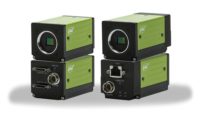The growing demand for more multi-functional cameras has made the machine vision market flush with new and exciting possibilities. Many line scan color cameras are leading the way, allowing the user to have control over each color band in the image without having to use more than one imager. Other manufacturers are incorporating complex, multi-scan functionality directly into their imagers and cameras through custom partitioning: a section that scans 3-D images, a section that performs a traditional grayscale line scan, a section that measures permeability, and so on.
Imagine a manufacturing landscape in which all of the data for a particular product could be gathered from one camera, in one scan, without the need for add-ons of any kind. As camera functionality continues to advance, speed, accuracy, and efficiency have followed suit, allowing for high-definition, multi-scan technology systems that provide multiple spectrums, types, and dimensions from a single camera in a single pass.
Jim Anderson, SICK’s national product manager, vision and 2d code readers, foresees many more exciting innovations to come.
Basic Definition
According to Anderson, multi-scan cameras are “devices that can take multiple images and sometimes different types of images simultaneously.”
“In the case of SICK, we offer a camera that can gather multiple types of images, including 3D range images, 3D intensity data, color images, line scan 2D, and a patented scan technology called scatter that captures the way in which the laser spreads when it hits the surface of the objects,” Anderson continues. “These can be used in virtually any combination and can be done at very high data rates.”
Brief History
“Cameras with multi-scan technology have been around for a number of years,” Anderson explains. “The first versions of multi-scan cameras from SICK were designed for customers in the wood and lumber industry. The multi-scan 3D cameras allowed for high-speed grading and defect detection in wood using 3D structure data and scatter data to detect changes in the grain of the wood.”
“Over the years, this technology has found uses in many industries — ranging from color and 3D images in the food and beverage industry for verifying the shape, size, and color of food products to images captured in the tire industry to read the codes and text on tires — while inspecting the overall structure of an object that can be difficult to inspect due to its lack of contrast.”
Current Trends
So, how are multi-scan cameras changing the industry today?
“There are several advancements and innovations that have made their way into multi-scan cameras, from the ability to capture many different wavelengths of light for creating greater understanding of what is going on with an object from a single camera to more standard improvements like speed,” notes Anderson. “In some cases, there are cameras now that can capture nearly high-definition images at a rate of more than 10,000 images per second.”
“The use of these multi-scan cameras in industry is providing the manufacturers that use them with more data at faster speeds than ever before,” Anderson continues. “This trend to capture as much data as you can on a product or process without hindering the throughput is one that does not seem to be slowing down. Even if the data that is being collected is something that does not have current value, companies are using the information to improve the procedures and products they use and make by analyzing the data and finding trends that can either save them money or improve their product.”
What’s Next?
“The overall machine vision industry is headed full speed into creating, capturing and handling data on a much larger scale,” says Anderson. And since cameras are taking higher and higher resolution images at higher acquisition rates, the storage of these images must then require “more and more sophisticated life cycle management, so the data can be preserved at full resolution and compressed more and more as time passes, and still be searchable so a user can go back and compare data or read rates on similar objects over time.”
“This is the next big step for industry,” Anderson concludes. “Cameras, especially multi-scan cameras, can and do create such high amounts of data, [and] the actual bandwidth data storage of this data is where companies and users will start to separate themselves from the other competitors in the field.”




